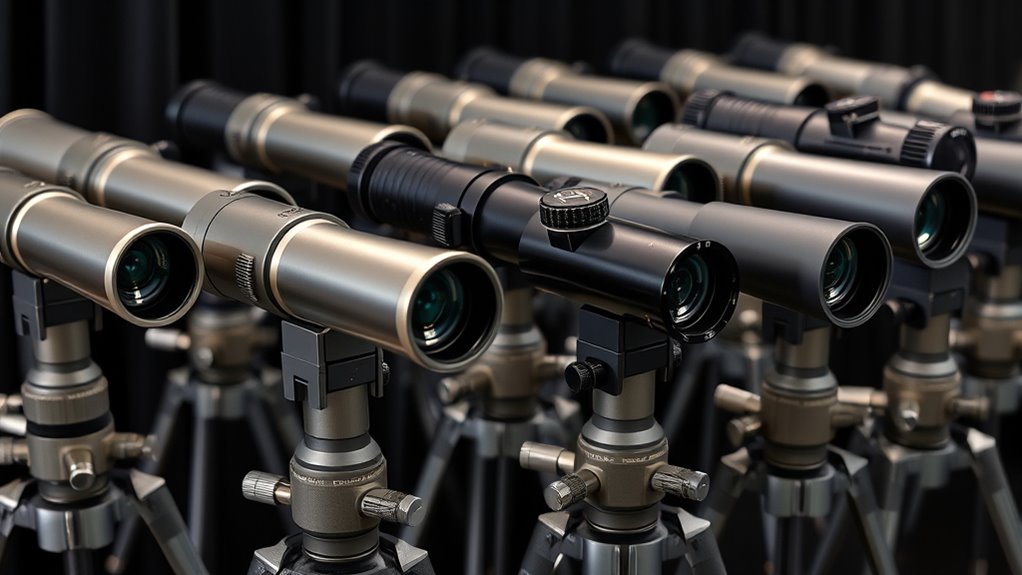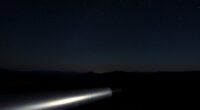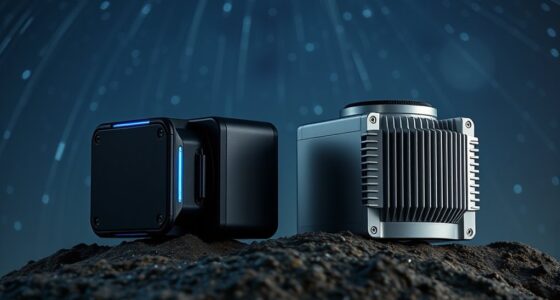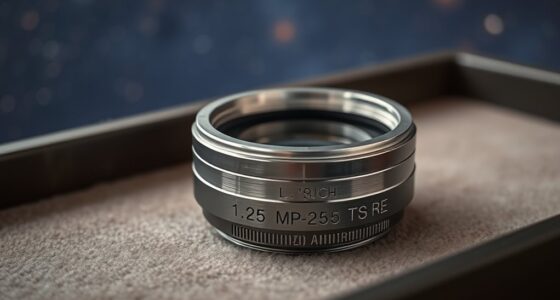If you’re searching for the best 2-inch guide scopes for astrophotography in 2025, I’ve found top options that blend optical quality, versatility, and durability. From the lightweight SVBONY SV106 to the precise SV165 mini guide scope and the adaptable Astromania kits, these scopes support guiding, searching, and imaging. Each offers excellent build quality and compatibility with popular cameras and accessories. Keep exploring to discover which guide scope fits your setup and imaging goals.
Key Takeaways
- Highlights top guide scopes with 2-inch aperture for enhanced guiding accuracy and bright star images.
- Emphasizes compatibility with popular auto-guiding cameras and mounting systems for versatile astrophotography setups.
- Details optical features like multi-coated lenses, precise focusing mechanisms, and durable construction.
- Considers portability, build quality, and ease of integration with various telescopes and accessories.
- Provides insights into pros, cons, user ratings, and practical use cases for each recommended guide scope.
SVBONY SV106 Guide Scope with Helical Focuser Finder and Guide Scope Multi-Use for Astronomical Telescope
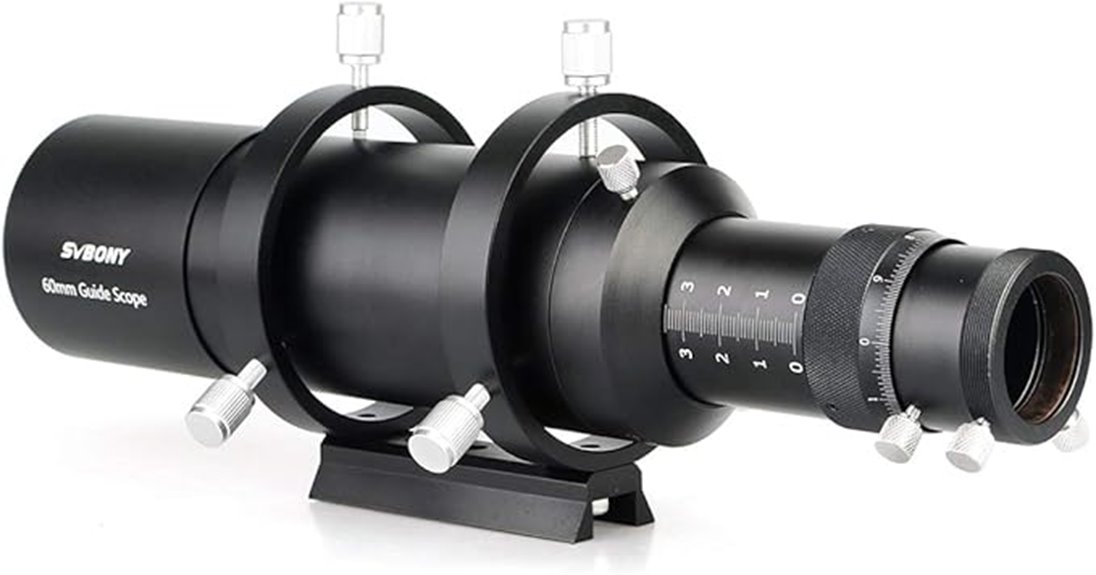
If you’re looking for a versatile guide scope that simplifies astrophotography, the SVBONY SV106 is an excellent choice. It features a 60mm aperture with a built-in helical focuser, allowing precise focusing of guide stars and improving imaging accuracy. It doubles as a straight-through finder with an optional 1.25″ eyepiece, making aiming quick and straightforward. The scope offers bright, crisp images with minimal distortions, thanks to its anti-reflection coating. Its solid construction includes a telescoping drawtube and secure compression rings, ensuring stability. Weighing just 1.74 pounds, it’s easy to mount on various telescopes, making it a versatile tool for astrophotographers.
Best For: amateur astronomers and astrophotographers seeking a versatile, easy-to-use guide scope for guiding, finder work, and wide-field imaging.
Pros:
- Bright, crisp images with minimal distortion and anti-reflection coating for optimal clarity.
- Dual focusing system with smooth, precise adjustments and secure locking features.
- Lightweight and solid construction, compatible with various telescopes and guide cameras.
Cons:
- Some users report minor issues with screw tightness or focus lock effectiveness.
- Back-travel and focusing adjustments may require fine-tuning for perfect focus.
- Slightly limited back-travel (up to 35mm) may require care during focus adjustments.
SVBONY SV165 Mini Guide Scope 30mm F4 Finder
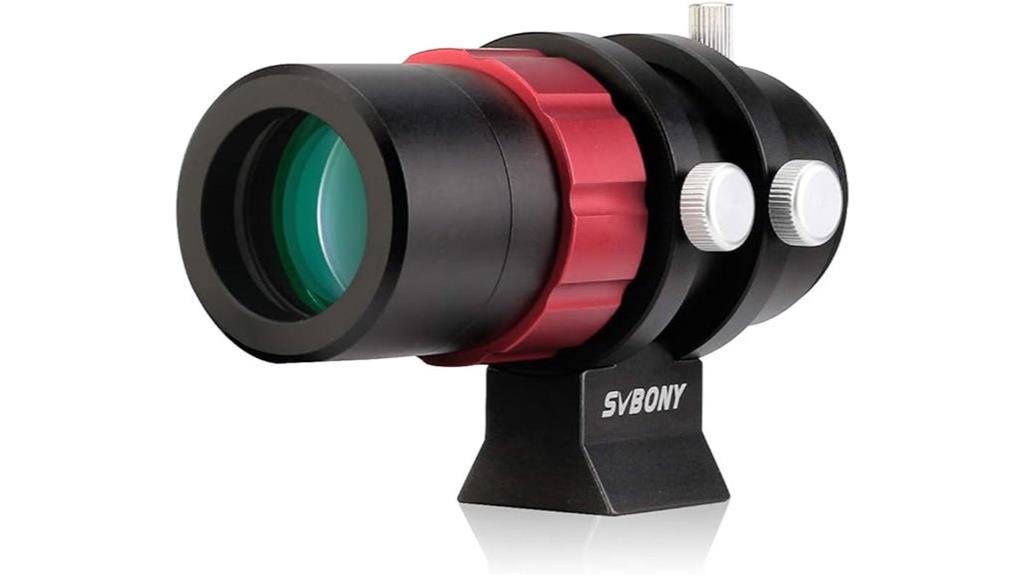
The SVBONY SV165 Mini Guide Scope 30mm F4 Finder stands out as an excellent choice for astrophotographers seeking a lightweight, cost-effective guiding solution. It’s compatible with popular auto-guiding cameras like SV305 Pro, ZWO, and QHY, offering flexible mounting with 1.25-inch and M42 interfaces. Its ultra-wide band multilayer coated lens guarantees bright, clear images, while the F4 aperture provides a broad field of view for quick target acquisition. Built with durable CNC metal, it’s compact and lightweight—just over 12 ounces. Rated 4.5 stars, it reliably guides at under 1 arc-second accuracy, making it ideal for small to medium telescopes.
Best For: amateur astrophotographers and stargazers seeking a lightweight, affordable guide scope compatible with popular auto-guiding cameras for small to medium telescopes.
Pros:
- Compatible with mainstream auto-guiding cameras like SV305 Pro, ZWO, and QHY with flexible mounting options.
- Bright, clear images due to ultra-wide band multilayer coated lens and 30mm achromatic optics.
- Compact, lightweight design (just over 12 ounces) with durable CNC metal construction, making it portable and easy to handle.
Cons:
- Not compatible with dielectric mirror star diagonals, requiring additional accessories for focusing in some setups.
- Less effective for guiding at very high focal lengths (e.g., 2000mm), ideal mainly for focal ratios around F4 to F6.
- Some users may need to customize focus alignment or add accessories for optimal matching with their main telescopes.
Astromania 50mm Compact Finder Scope Kit
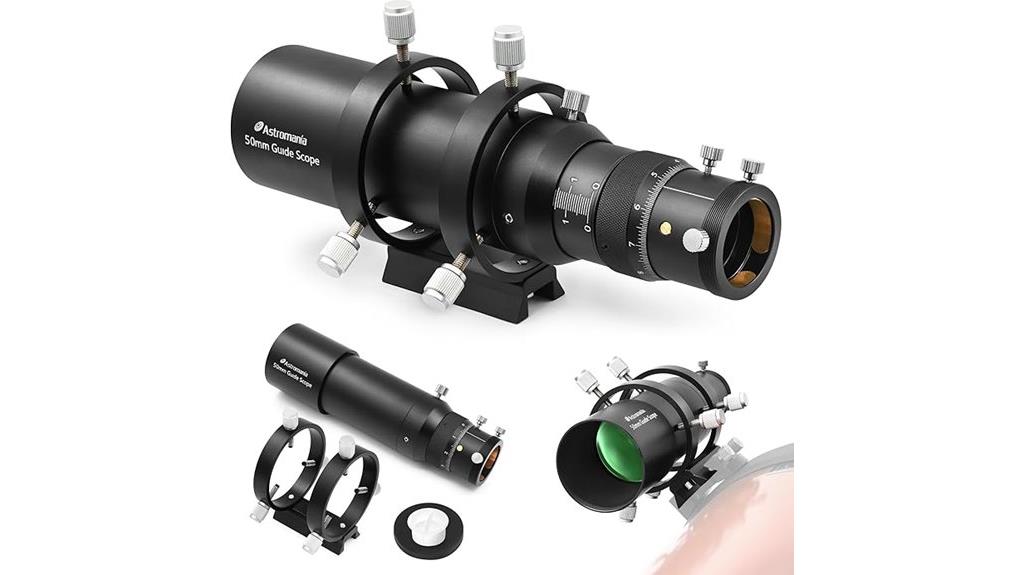
The Astromania 50mm Compact Finder Scope Kit stands out as an excellent choice for astrophotographers seeking a lightweight, durable guide scope. It features a 200mm focal length, ideal for guiding telescopes up to 1500mm, with wide-field optics to locate guide stars easily. Compatible with 1.25-inch eyepieces, it offers customizable magnification. The scope’s sturdy black anodized aluminum build guarantees durability, while the built-in worm focuser provides precise adjustments with a 40mm focusing range. Easy to mount with included clamps and dovetail plates, it’s versatile for various setups. Overall, it’s a reliable, high-quality guide scope perfect for astrophotography.
Best For: amateur astrophotographers and stargazing enthusiasts seeking a lightweight, durable guide scope for guiding telescopes and wide-field imaging.
Pros:
- Sturdy black anodized aluminum construction ensures durability and robustness
- Precise focus adjustments with built-in worm focuser and knurled rings
- Compatible with 1.25-inch eyepieces for customizable magnification and easy setup
Cons:
- Limited focusing range may restrict use with 90-degree diagonals for certain viewing angles
- Additional adapters may be needed for guiding cameras like Lodestar X2
- Not suitable for standalone high-power visual observation without additional accessories
Astromania Off-Axis Guider with Micro-Focusing

For astrophotographers seeking precise guiding without the added bulk of a guide scope, the Astromania Off-Axis Guider with Micro-Focusing stands out. It’s designed for various telescopes, including refractors, Schmidt-Cassegrain, Maksutov, and Richey-Chrétien models, helping correct tracking errors during long exposures. Its compact size—just 24mm long—makes it versatile and easy to integrate. Equipped with a 2-inch focuser, M48 threading, and a micro-focusing system with 0.05mm precision, it allows fine adjustments to ensure sharp guide stars. While some users report limitations like tilt adjustment and compatibility issues, overall, it offers a lightweight, effective guiding solution for serious astrophotographers.
Best For: astrophotographers seeking a lightweight, precise guiding solution compatible with various telescope types without the need for a guide scope.
Pros:
- Compact and lightweight design (24mm length) for easy integration.
- Micro-focusing system with 0.05mm precision for sharp guide star adjustments.
- Suitable for multiple telescope types, including refractors and SCTs, with effective handling of reducers and flatteners.
Cons:
- Lack of tilt adjustment on the prism may impact image quality.
- Compatibility issues with certain telescopes and reducers, such as Celestron C6.
- Some users report light transmission problems and obstructed image circles.
SVBONY SV198 Guide Scope, 50mm Finder Scope with Helical Focuser
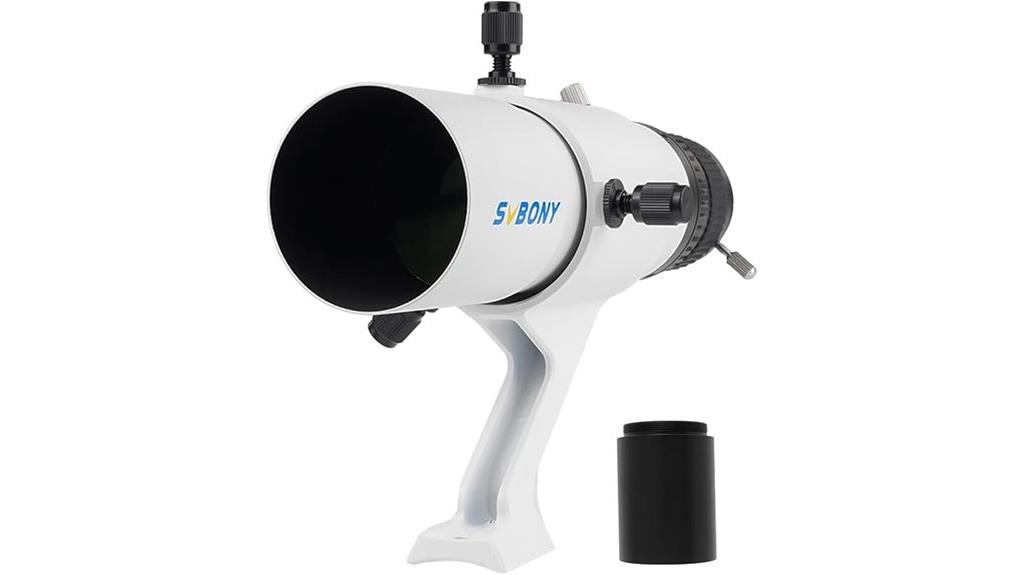
If you’re looking for a versatile guide scope that combines ease of use with solid optical performance, the SVBONY SV198 50mm Finder Scope is an excellent choice. It features a 50mm aperture for bright, detailed views, with fully multi-coated optics that deliver high contrast and clarity. Its dual focusing system, including a precise helical focuser and push-pull option, makes focusing smooth and adaptable. Weighing just 2.4 pounds and measuring about 12.6 x 8.66 x 3.54 inches, it’s portable and easy to mount on various setups. Whether guiding, searching, or visual observing, this scope offers reliable performance at an attractive price point.
Best For: amateur astronomers and astrophotography enthusiasts seeking a lightweight, versatile guide scope for guiding, searching, and visual observation.
Pros:
- Large 50mm aperture provides bright, detailed views with high contrast.
- Fully multi-coated optics enhance image clarity and reduce reflections.
- Dual focusing options offer precise and adaptable focusing methods.
Cons:
- Sticky grease on the helical focuser can make focusing difficult in cold conditions.
- Limited adjustment screws in newer mounting designs may reduce calibration precision.
- Potential durability concerns, such as the focuser breaking after extended use.
Sky-Watcher EvoGuide 50DX Guide Scope
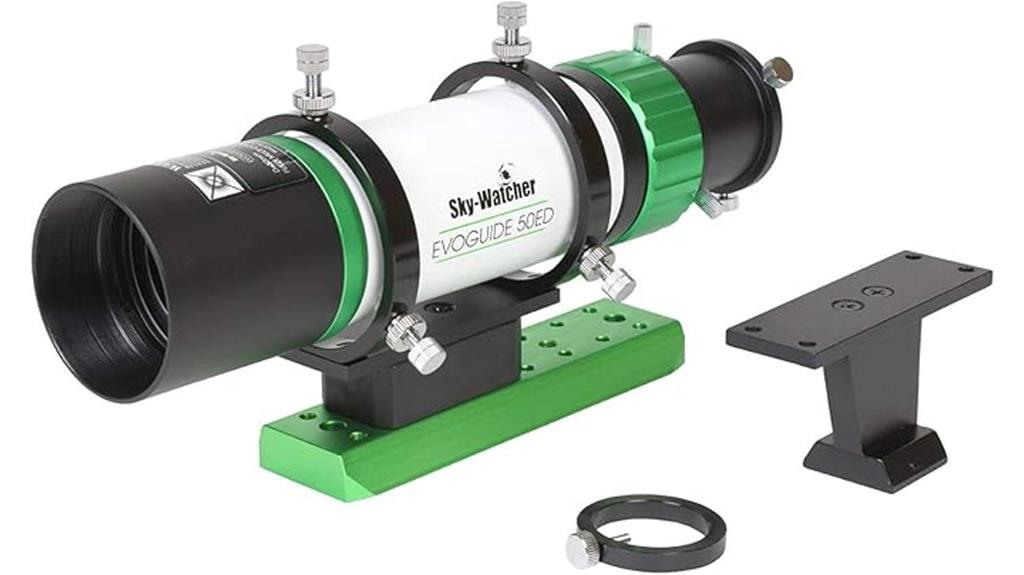
The Sky-Watcher EvoGuide 50DX Guide Scope stands out as an excellent choice for astrophotographers seeking precise guiding and wide-field imaging in a compact package. Its 50mm f/4.8 apochromatic doublet design, paired with ED glass, delivers sharp, contrast-rich views and minimal chromatic aberration. Weighing just 2.7 pounds with a portable size, it’s easy to mount and transport. The scope features a 242mm focal length, a 1.25” helical focuser, built-in T-threads, and a V-style mounting rail. It’s versatile for guiding with ZWO cameras or imaging with DSLRs, especially when combined with a field flattener for wide-field astrophotography.
Best For: amateur and semi-professional astrophotographers seeking a portable, high-quality guidescope and wide-field imaging solution.
Pros:
- Excellent guiding accuracy with reduced guide star sizes, ideal for precise astrophotography
- Compact, lightweight design (2.7 pounds) makes it highly portable and easy to mount
- Sharp, contrast-rich images thanks to ED glass and apochromatic doublet construction
Cons:
- Crude helical focuser can be challenging for fine focus adjustments
- Minor manufacturing imperfections like hardened substances or tight screws may require attention
- Overkill as a guidescope for some users, though excellent for wide-field imaging
Astromania 70mm Guide Scope with Helical Focuser and Finder for Astrophotography
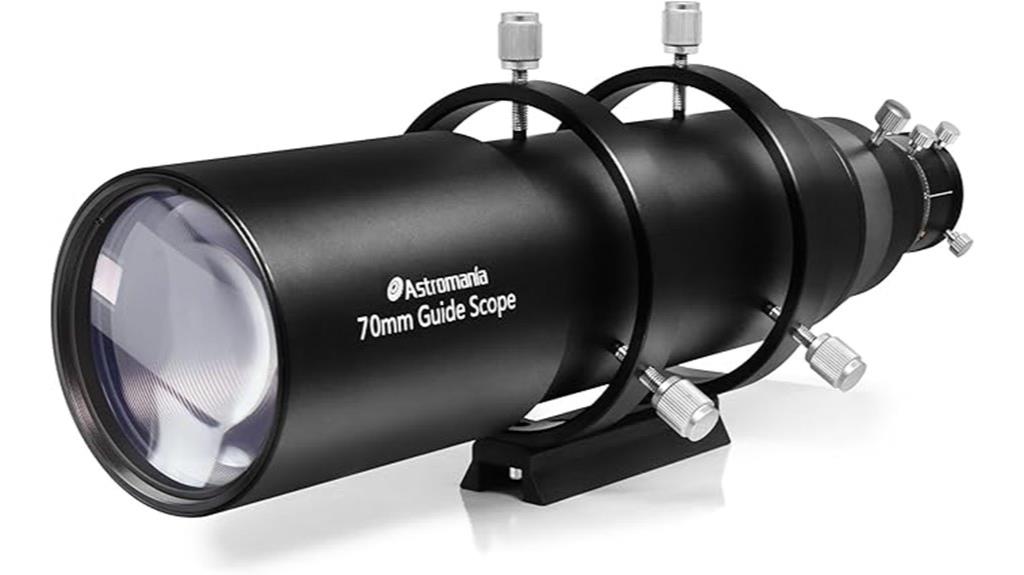
The Astromania 70mm Guide Scope stands out as an excellent choice for astrophotographers seeking reliable guiding at an affordable price. Its 400mm focal length offers bright, wide-field optics with numerous guide stars, making target identification straightforward. Constructed from sturdy black anodized aluminum, it features a micro-helical focuser with brass compression rings and a lock thumbscrew, ensuring precise focus adjustments. The scope includes a built-in worm-focuser, a finder, and a slide-out dew shield. Compatible with most mounts, it’s easy to install and adjust. Its high-quality achromatic lens produces sharp stars with minimal aberration, making it ideal for guiding and beginner astrophotography.
Best For: amateur astrophotographers and stargazers seeking a reliable, high-quality guide scope for guiding and beginner astrophotography at an affordable price.
Pros:
- Bright, wide-field optics with numerous guide stars for easy object and star identification.
- Solid construction with precise focus adjustment via micro-helical focuser and brass compression rings.
- Compatible with most mounts, supporting guiding up to 2400mm focal length with standard cameras.
Cons:
- Larger size and weight may challenge mounts with lower capacity.
- No adjustable front corrector or angled sight, limiting some advanced guiding options.
- Dew shield may require modification or longer extensions for optimal dew prevention.
SVBONY Dovetail Base for Finder Scope Mount
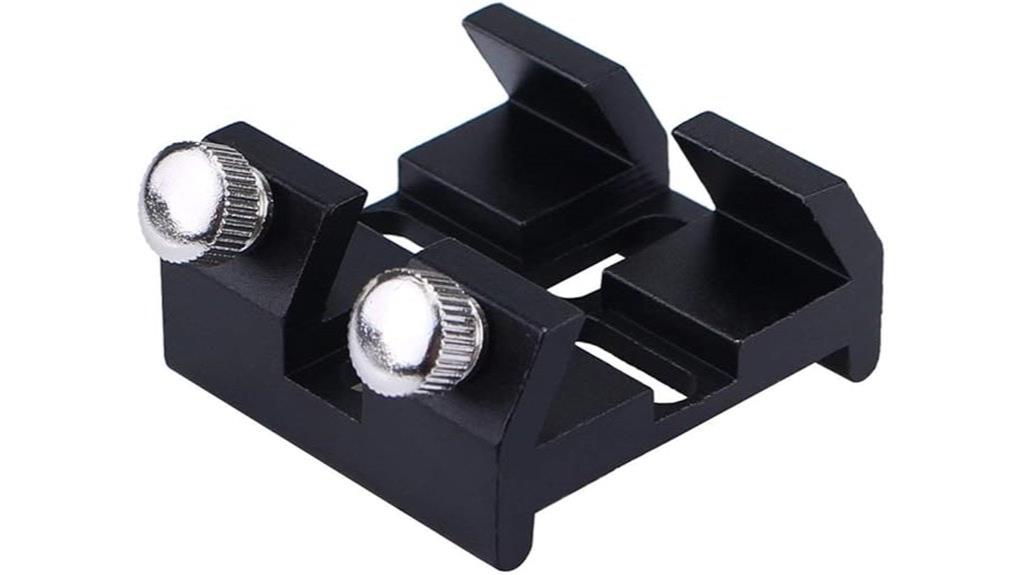
For astronomers seeking a versatile and secure mounting option, the SVBONY Dovetail Base for Finder Scope Mount stands out as an excellent choice. Made from high-strength, anodized aluminum, it’s lightweight and durable, fitting telescopes from brands like Celestron, Orion, Sky-Watcher, and Vixen. Its dovetail slots allow easy customization, and the two large thumb screws ensure a firm, stable attachment for finder scopes or reflex sights. With dimensions around 2.16 x 1.37 x 2.36 inches and weighing just 1.44 ounces, it’s simple to install and highly reliable. Rated 4.6 stars, users praise its sturdiness, ease of use, and excellent value for enhancing telescope aiming.
Best For: Amateur and professional astronomers seeking a versatile, durable, and easy-to-install mounting solution for finder scopes on various telescopes.
Pros:
- Made from high-strength, anodized aluminum for durability and lightweight handling
- Compatible with popular telescope brands like Celestron, Orion, Sky-Watcher, and Vixen
- Features large thumb screws and dovetail slots for secure, customizable attachment
Cons:
- Over-tightening screws may cause bending, requiring realignment
- Slightly limited in size, may not fit very large or unconventional telescope tubes
- Installation may require careful handling to avoid damaging the anodized finish
SVBONY Dovetail Base for Finder Scope
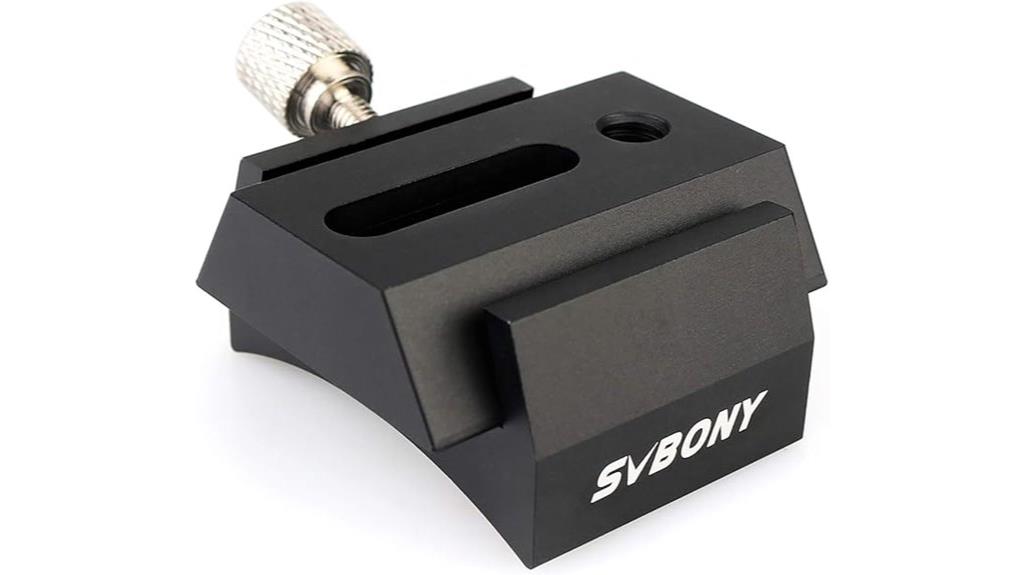
If you’re looking to enhance your telescope’s aiming capabilities, the SVBONY Dovetail Base for Finder Scope offers a versatile solution. It’s compatible with finder scopes, reflex sights, and laser pointers, making it easy to add second or third aiming devices for better targeting. Designed to fit most brackets from popular brands like Celestron, Orion, Sky-Watcher, and Vixen, it provides broad compatibility. Made from durable metal, it guarantees stability and long-lasting performance. The quick-release dovetail board allows for easy installation and removal, while the cambered bottom ensures a snug fit and added stability during use.
Best For: amateur astronomers and telescope enthusiasts looking to enhance their aiming options with versatile, compatible finder scope mounts.
Pros:
- Compatible with multiple popular telescope brands like Celestron, Orion, Sky-Watcher, and Vixen
- Made from durable metal for reliable strength and longevity
- Easy to install and remove with quick-release dovetail design, providing added stability during observations
Cons:
- May require additional adapters for some specific telescope models
- Limited to dovetail width of 42mm, which may not fit very specialized setups
- All-metal construction, while durable, could be heavier compared to plastic alternatives
Digiscoping S1 Spotting Scope Universal Phone Adapter
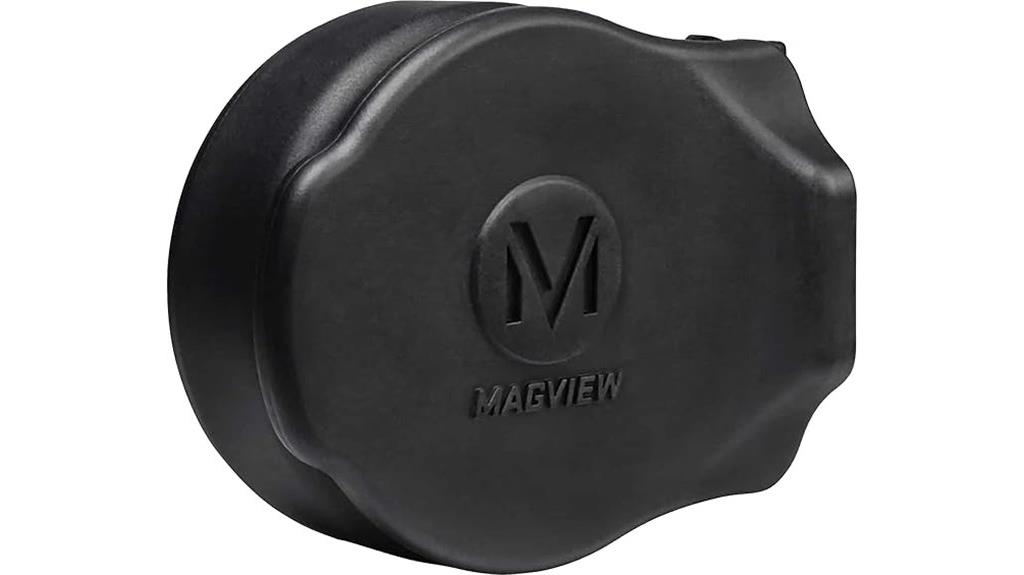
Designed specifically for digiscoping enthusiasts, the MAGVIEW Digiscoping S1 Spotting Scope Universal Phone Adapter offers a quick and secure way to attach smartphones to spotting scopes. It fits eyepieces 51mm-60mm in diameter and includes a magnetic metal plate for easy alignment. Installation takes about five minutes via the MAGVIEW app, and users can achieve precise, stable images at magnifications from 20x to 60x. The adapter’s durable plastic construction and magnetic attachment guarantee a secure fit, though the metal plate requires a flat phone case. Overall, it’s a reliable, user-friendly tool for capturing high-quality images and videos through your scope.
Best For: outdoor birdwatchers, wildlife observers, and digiscoping enthusiasts seeking an easy-to-use, high-quality phone adapter for capturing images through spotting scopes.
Pros:
- Quick and straightforward installation using the MAGVIEW app, typically in about 5 minutes
- Strong magnetic attachment ensures a secure, stable connection between phone and scope
- Compatible with various scopes and provides high-quality images at magnifications from 20x to 60x
Cons:
- Metal plate requires a flat phone case and is permanently attached, limiting flexibility
- Neoprene eyepiece cover can be difficult to slide over when the adapter is attached
- Attaching the adapter can prevent fully zipping scope carrying cases, which may be inconvenient
Bushnell Trophy Xtreme Spotting Scope 20-60x65mm
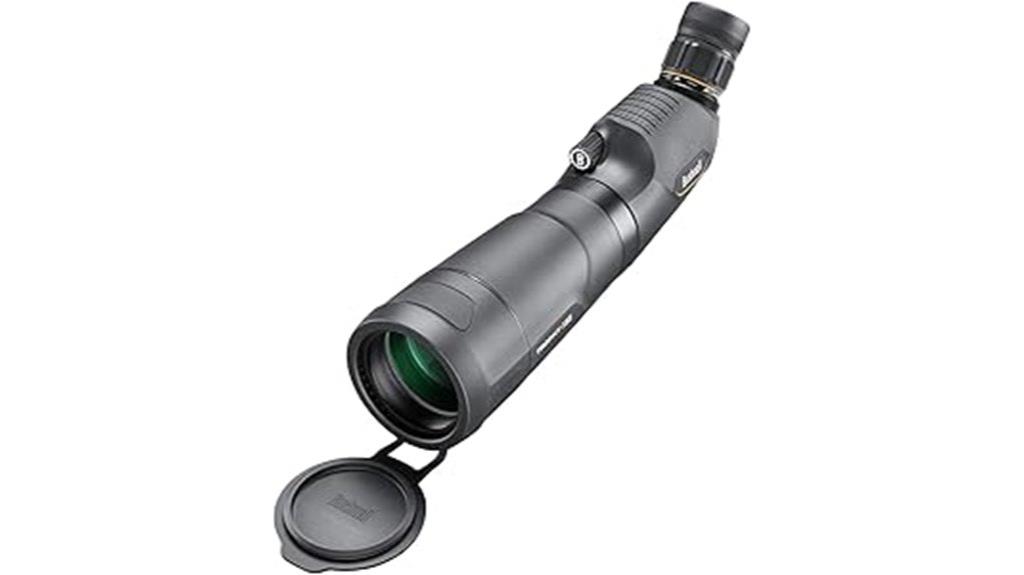
The Bushnell Trophy Xtreme Spotting Scope 20-60x65mm stands out as a versatile option for outdoor enthusiasts who need a durable, all-weather scope capable of long-range viewing. Its rugged rubber armor and waterproof, nitrogen-purged design guarantee reliability in harsh conditions. With fully multi-coated lenses, it provides bright, high-contrast images across its 20x to 60x magnification range. Although it’s portable and suitable for target shooting, bird watching, and hunting, some users report inconsistent image quality at higher magnifications and note the absence of a tripod. Overall, it’s a solid budget-friendly choice, especially for casual users seeking durable, all-weather optics.
Best For: outdoor enthusiasts seeking a durable, all-weather spotting scope for casual bird watching, target shooting, and hunting in various weather conditions.
Pros:
- Rugged rubber armor enhances durability and grip.
- Waterproof and nitrogen-purged design ensures reliable performance in wet or dusty environments.
- Fully multi-coated lenses provide bright, high-contrast images across a wide magnification range.
Cons:
- Mixed image quality at higher magnifications, with some users experiencing blurriness.
- Lack of included tripod or accessories complicates steady viewing.
- Some users find the eye relief insufficient for comfortable extended use.
Astromania Adjustable Guiding Scope Ring Set (Pair)
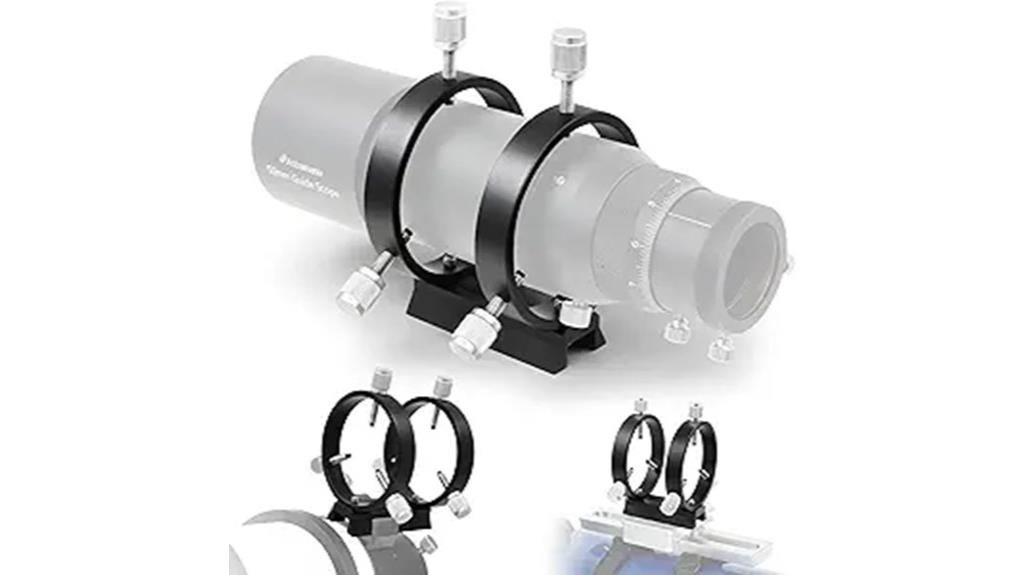
For astrophotographers seeking reliable and precise guiding, the Astromania Adjustable Guiding Scope Ring Set (Pair) stands out as an excellent choice. Designed for telescopes with tube diameters between 43mm and 68mm, these solid metal rings feature machined, smooth surfaces and a flawless coating. They include large knurled screws with Teflon inlays to prevent scratches, ensuring secure clamping without damage. Compatible with various accessories like Astro-Tech 60mm APO refractors and Canon lenses, they’re versatile for guiding and finder scopes. With a user-rated 4.4 out of 5 stars, these durable, easy-to-use rings provide excellent value for precise guiding in astrophotography.
Best For: astrophotographers and amateur astronomers seeking reliable, adjustable guiding scope rings for small to medium-sized telescopes and guiding accessories.
Pros:
- Made of solid metal with machined, smooth surfaces and flawless coating for durability and aesthetic appeal
- Large knurled screws with Teflon inlays prevent scratches and ensure secure, damage-free clamping
- Versatile compatibility with various guide scopes, finderscopes, and accessories like Canon lenses and APO refractors
Cons:
- Mounting hardware may need to be purchased separately, as some users report requiring additional hardware for installation
- Slightly limited to tube diameters between 43mm and 68mm, restricting use with larger scopes
- The product’s size and weight (3.5 x 3.9 x 3.9 inches, 5.3 ounces) may be less suitable for ultra-lightweight or minimalist setups
Monstrum Offset Scope Mount with Anti-Cant Bubble
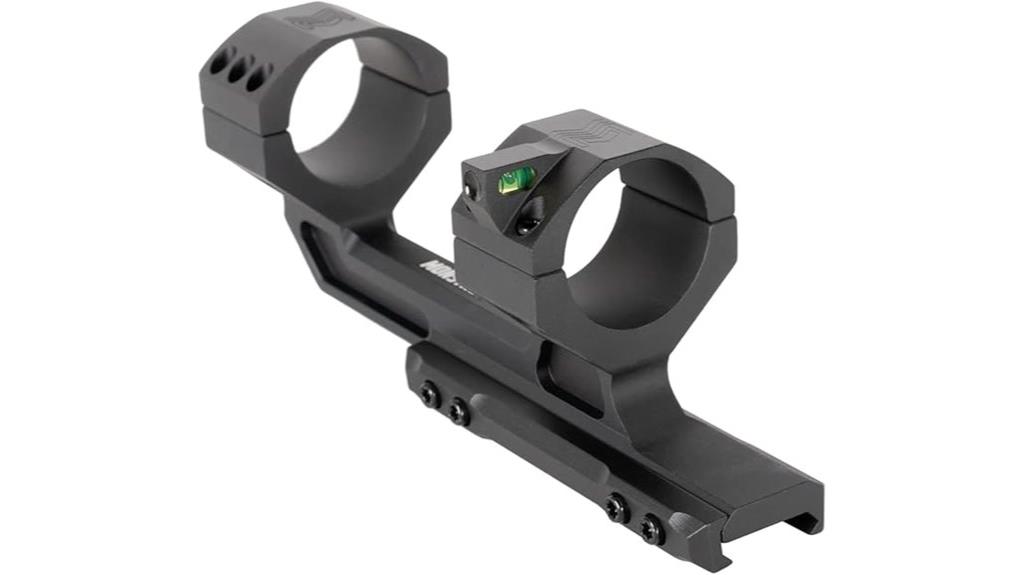
If you’re aiming for precise astrophotography, the Monstrum Offset Scope Mount with Anti-Cant Bubble is a smart choice because it helps guarantee perfect scope alignment in demanding conditions. Its rugged build and reliable design ensure durability, while the integrated anti-cant level bubble allows me to quickly verify and maintain vertical alignment before each shot. The 2-inch offset extension provides better eye relief and ergonomic positioning. With a secure Picatinny mount and custom locking bolts, it offers zero wiggle and maximum stability. Overall, this mount helps reduce scope cant errors, improving shot consistency and accuracy, making it ideal for demanding astrophotography sessions.
Best For: precision shooters and astrophotographers seeking reliable scope alignment and enhanced accuracy in challenging conditions.
Pros:
- Integrated anti-cant level bubble for quick and accurate scope alignment
- Rugged, durable construction suitable for demanding environments
- Offset design with 2-inch extension for improved eye relief and ergonomics
Cons:
- May require additional installation time due to offset positioning
- Slightly higher cost compared to standard mounts without anti-cant features
- Compatibility limited to Picatinny rails, requiring specific firearm setups
Finder Scope Guiding Scope Ring Kit for Telescope Adjustments
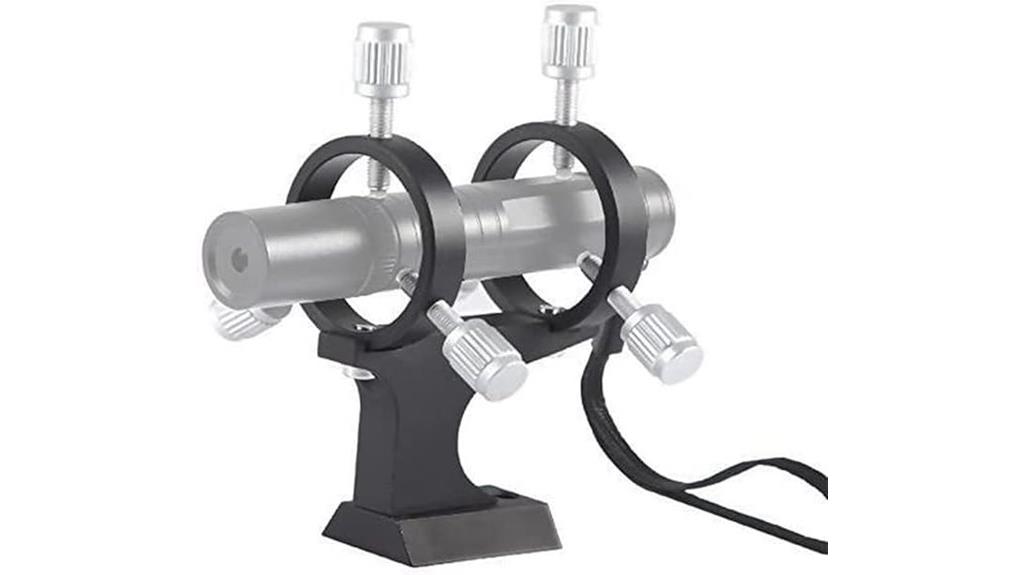
A Finder Scope Guiding Scope Ring Kit stands out as an essential accessory for serious astronomers seeking precise telescope adjustments. Made from high-quality aluminum with a durable black oxide finish, it resists corrosion and guarantees long-lasting use. The kit accommodates laser pointers ranging from 5mm to 38mm, making it versatile for various setups. Its three-point knurled knobs allow quick, secure adjustments, ensuring accurate alignment. Compatible with most dovetail mounts and popular brands like Celestron, Sky-watcher, and Vixen, it transforms a simple laser pointer into a reliable guiding tool. This kit simplifies aiming, improves accuracy, and enhances your astrophotography experience.
Best For: Serious amateur and professional astronomers seeking precise and reliable telescope alignment and guiding during stargazing and astrophotography sessions.
Pros:
- Made of durable high-quality aluminum with a corrosion-resistant black oxide finish.
- Compatible with laser pointers from 5mm to 38mm, offering versatile application across different setups.
- Features three-point knurled knobs for quick, secure, and accurate adjustments.
Cons:
- May require additional accessories for optimal use with certain telescope mounts.
- Heavier than plastic alternatives, potentially adding slight weight to telescope accessories.
- Compatibility depends on dovetail mounts; some telescope models may need adapters.
Vixen 3562-01 Astronomical Telescope Tripod Adapter
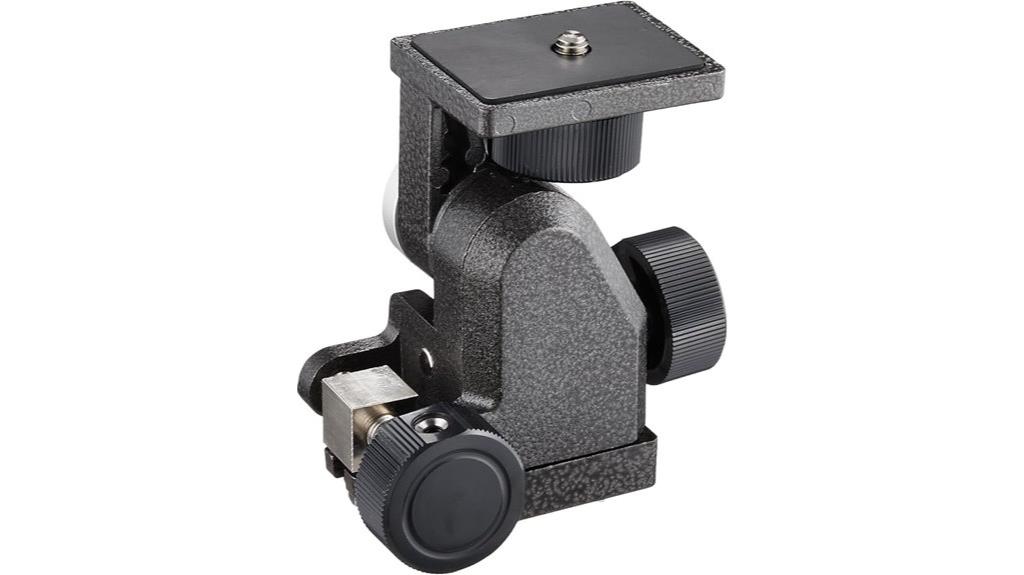
The Vixen 3562-01 Astronomical Telescope Tripod Adapter stands out as an essential tool for astrophotographers who need precise micro-adjustments when aligning their telescopes or cameras. Its compact design—just 3.4 inches tall and weighing 12.8 ounces—makes it highly portable. The microtremor head offers ±10° movement in all directions, allowing fine-tuning for accurate targeting. Compatible with small telescopes, guide scopes, and cameras, it mounts easily on standard tripods. Users praise its stability and smooth adjustments, especially for high-magnification lunar and planetary imaging. While discontinued, it remains a popular choice for hobbyists seeking reliable, precise micro-movements to enhance their astrophotography setups.
Best For: amateur and professional astrophotographers who require precise micro-adjustments for celestial imaging with small telescopes and cameras.
Pros:
- Provides smooth and stable micro-movements for accurate target alignment.
- Compact, lightweight, and highly portable, suitable for field use.
- Compatible with various small telescopes, guide scopes, and cameras for versatile application.
Cons:
- Limited adjustment range of ±10°, which may not suit very large or heavy equipment.
- Discontinued product, potentially affecting availability and warranty support.
- Less suitable for heavy-duty or prolonged high-load astrophotography setups.
Factors to Consider When Choosing a 2 Inch Guide Scope
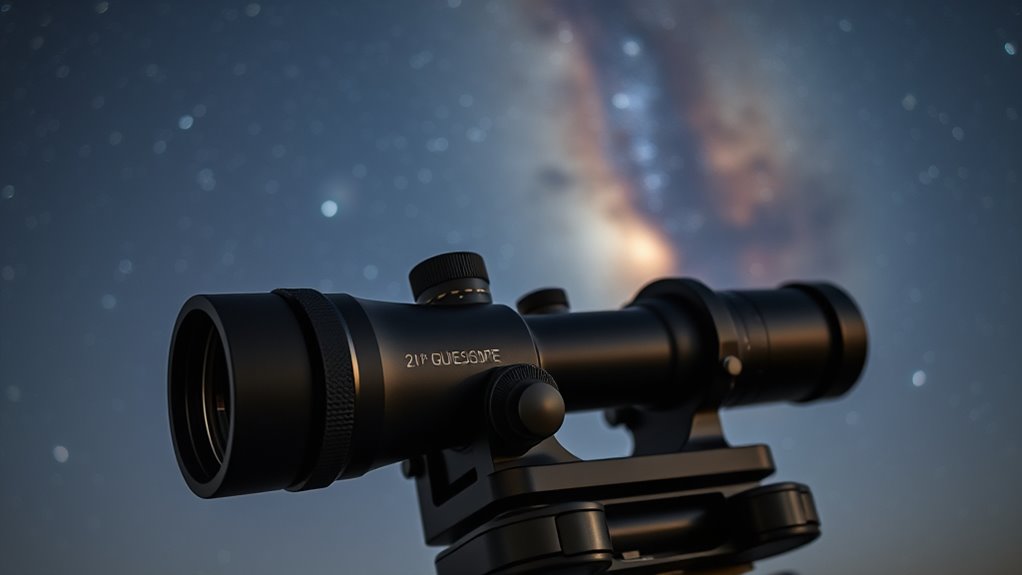
When selecting a 2-inch guide scope, I focus on optical quality, brightness, and how well it fits my mount. I also consider the focusing mechanism’s precision, as well as its size and weight for easy handling. Finally, I look at its versatility for different imaging setups to guarantee it meets my astrophotography needs.
Optical Quality and Brightness
Optical quality and brightness are key factors because they directly influence the precision and ease of guiding during astrophotography. High optical quality guarantees sharper, more accurate star images, which are essential for precise guiding. Brightness, tied to the aperture size, makes guide stars easier to see in low-light conditions, especially when atmospheric conditions aren’t ideal. Multi-coated optics reduce reflections and glare, increasing contrast and clarity across the field of view. Apochromatic or achromatic lenses minimize chromatic aberration, guaranteeing stars appear as sharp points without color fringing, boosting guiding accuracy. A well-constructed, bright guide scope allows for shorter exposure times, helping to reduce guiding errors caused by atmospheric turbulence. Together, these qualities are vital for achieving high-precision astrophotography results.
Mounting Compatibility Options
Choosing a guide scope that’s compatible with your mount setup guarantees stable and accurate guiding. First, check if the guide scope’s mounting base fits your telescope’s dovetail or rail system, like Synta or Vixen styles. Adjustable mounting rings or dovetail plates are helpful—they secure the scope without damaging your tube and allow for precise positioning. It’s also vital to confirm your mount’s maximum load capacity can support the combined weight of the guide scope, camera, and accessories. Additionally, make certain the mounting hardware includes screws, clamps, or adapters that match your telescope’s diameter and mounting points. Finally, consider how easy it is to install and align the guide scope—stable attachment and precise aim adjustments during long sessions are essential for successful astrophotography.
Focusing Mechanism Precision
A key factor in selecting a 2-inch guide scope is the precision of its focusing mechanism, as it directly influences your ability to capture sharp, well-defined guide stars essential for accurate astrophotography. Micro-focusing helical focusers with at least 10mm of travel allow for fine adjustments, which improve guide star clarity and guiding accuracy. A smooth, backlash-free focusing system helps prevent vibrations and shifts during adjustments, guaranteeing consistent focus and stable guiding. Locking focus screws or brakes are crucial for maintaining focus once set, avoiding accidental movements that could compromise guiding precision. Additionally, the quality of the focusing mechanism—materials and construction—affects its durability and ability to deliver reliable, precise focus over long sessions. Prioritizing these aspects helps ensure ideal guiding performance.
Size and Weight Considerations
Since larger diameter guide scopes like 2 inches gather more light, they can detect fainter guide stars, which boosts guiding accuracy. However, their size and weight are important considerations. A 2-inch guide scope typically weighs between 1.3 and over 3 pounds. Heavier models may require sturdier mounts and can affect the overall balance of your setup, possibly leading to vibrations or stress during long exposures. If your mount isn’t rated for the added weight, guiding performance could suffer. Additionally, larger and heavier scopes may be less portable, making setup in the field more challenging. When choosing a guide scope, it’s essential to match its weight to your mount’s capacity and consider how much portability you need for your astrophotography sessions.
Versatility for Imaging
A flexible 2-inch guide scope offers the adaptability to perform guiding, wide-field imaging, and visual observations, making it a valuable all-in-one tool for astrophotographers. High-quality, multi-coated optics with large apertures like 50mm or 60mm ensure bright, sharp images across various applications. Its mounting options, such as dovetail plates and adjustable rings, allow quick switching between guiding and imaging roles without extensive reconfiguration. Versatile focusing mechanisms, like helical or micro-adjustable focusers, improve precision for both guiding and wide-field imaging. Compatibility with a range of cameras, T-threads, and eyepieces lets me seamlessly integrate accessories for different observational tasks. This adaptability means I can optimize my setup for different targets, conditions, and imaging styles without sacrificing performance or convenience.
Budget and Value
Choosing a guide scope that offers the best optical quality and features within your budget helps maximize value and performance. Look for scopes with multi-coated optics and sturdy construction, as these often deliver better image quality without a higher price tag. Balance cost against important features like focuser type, aperture size, and compatibility with your current astrophotography setup. While budget-friendly options might lack advanced focusing mechanisms or durable materials, they can still be effective if they meet your needs. Investing in a scope with proven reliability and positive user reviews generally provides better long-term value than choosing the cheapest option. Ultimately, prioritizing quality and features within your budget guarantees you get the most precise guiding without overspending.
Frequently Asked Questions
How Do Guide Scopes Improve Astrophotography Accuracy?
Guide scopes improve astrophotography accuracy by providing precise tracking of celestial objects. I attach a guide scope to my main telescope, and it helps me detect any drift or movement during long exposures. When it notices a star moving out of position, I can make quick adjustments to my mount. This ensures my images stay sharp and clear, capturing the universe in stunning detail without star trails or blurring.
What Are the Advantages of Using a 2-Inch Guide Scope?
Using a 2-inch guide scope offers me better light-gathering ability, which means I get brighter, more detailed guide stars. This helps me achieve more precise tracking during long exposures, reducing star trails and improving image quality. The larger aperture also provides a wider field of view, making it easier to find and lock onto guide stars quickly. Overall, it boosts my astrophotography accuracy and makes capturing stunning images more reliable.
Can Guide Scopes Be Used With Different Telescope Brands?
Yes, guide scopes can be used with different telescope brands. I’ve found that many guide scopes are designed with standard mounting options, making them versatile. Just make certain your guide scope’s mounting rings and dovetails are compatible with your main telescope. I always double-check the mounting hardware before purchasing. This flexibility allows me to improve my astrophotography setup without needing to buy a new guide scope each time I switch telescopes.
How Does Weather Affect Guide Scope Performance?
They say, “A smooth sea never made a skilled sailor,” and weather really impacts guide scope performance. When it’s windy, humid, or too cold, vibrations and atmospheric turbulence can throw off your tracking. I’ve found clear, stable conditions help my guide scope perform best, ensuring sharp images. So, I always check the forecast and stabilize my setup to minimize weather-induced issues, because good conditions are key to successful astrophotography.
What Maintenance Is Required for Optimal Guide Scope Operation?
I regularly clean my guide scope’s lens with a soft brush and lens cleaner to remove dust and debris. I also check for any loose connections or misalignments and tighten them as needed. Periodically, I inspect for dew buildup and use a dew shield if necessary. Keeping the scope covered when not in use and storing it in a dry place helps maintain peak performance and longevity.
Conclusion
Choosing the right 2-inch guide scope can considerably improve your astrophotography, and with over 70% of amateur astronomers reporting better image stability using guide scopes, it’s clear they make a difference. Whether you prefer compact designs like the SV165 or versatile options like the SVBONY SV106, there’s a perfect fit for your setup. Investing in quality guarantees sharper images and more successful nights under the stars—so get ready to capture the cosmos with confidence!
